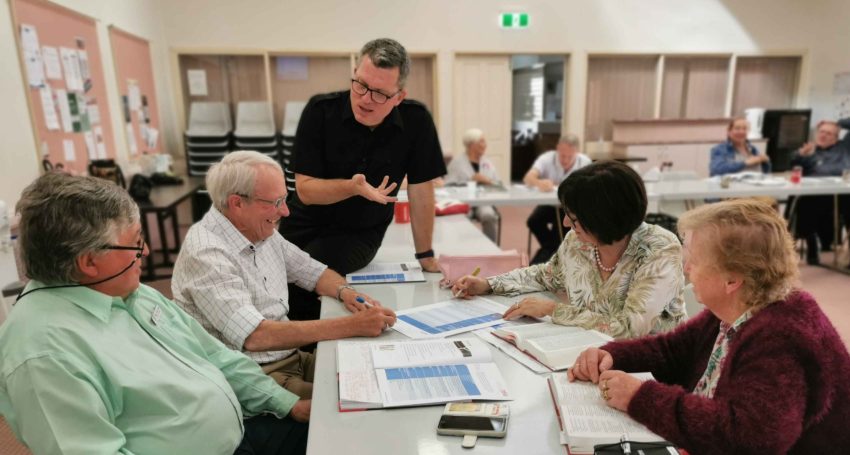Theological reflection through the Pastoral Spiral
Features
“Theological reflection, or TR, is an ancient idea. There are many ways to do it, but one of the simplest is the method known as the Pastoral Cycle or Spiral. Developed back in the 1980s and influenced by Ignatian spirituality, the Pastoral Spiral can be used by individuals in their daily life,” says Jonathan Sargeant from St Francis College

Faith and life – we know they’re connected, but how exactly? How do we make decisions, acknowledging the foundational nature of God in our lives? How do we know God is acting in our lives, day to day? And, because God is the basis of our lives, how do we make sure we’re learning from our life experiences? How do we learn and grow in our faith?
These are big questions, although possibly a bit abstract. Starting with an example is a good idea.
Mary and Carolyn leave the theatre, chatting about the film they’ve just watched.
“It was good,” says Mary. “I love that main actor. She’s terrific!”
“Yes,” agrees Carolyn. “She’s always great. And, I really liked all of the faith stuff sprinkled through the film, too. They did a good job with that.”
“Faith stuff? What do you mean?” asks Mary, blankly.
“You know, where they…that bit where…when they…” Carolyn struggles. She had an intuitive sense the film contained all kinds of faith allusions but articulating these were another thing altogether. Faith references were there, surely, but she didn’t know how to start in putting these into words.
For some of us, reflecting on our experience and seeing the presence of God from moment to moment comes naturally. But not for many of us! Most of us have a sense here and there, but it can take work to crystalise it. When I say work, I don’t mean plucking a Bible verse that seems to sync with our experience. That kind of ‘proof texting’ can seem helpful, but it too often ignores more foundational biblical messages or the wider context in which verses are situated. Probably more importantly, this kind of approach overlooks more helpful ways to read and engage with the Bible.
Advertisement
No, the work I’m referring to, or more accurately the method we can use to answer some of life’s big questions as mentioned in the first paragraph, is simple. It’s a process we refer to as “theological reflection”. Theological reflection, or TR, is an ancient idea. There are many ways to do it, but one of the simplest is the method known as the Pastoral Cycle or Spiral. Developed back in the 1980s and influenced by Ignatian spirituality, the Pastoral Spiral can be used by individuals in their daily life. It also finds expression in the world of academia, or even when church groups try to figure out how to engage with their communities more effectively. So, yes, it’s widespread in usage and super useful. Here’s how it works.
In the Pastoral Spiral there are four steps, sometimes called ‘movements’. These are
- Experience
- Analysis
- Reflection
- Response.
This method is called a ‘spiral” because it’s open-ended. When you’ve passed the fourth movement, you move onto the next experience for reflection. But, I’m getting ahead of myself. Let’s look at each step, using the example of Mary and Carolyn’s film-going experience.
The first movement is “Experience”. Something has happened and you decide to reflect on it. It might be an incident in your life, say, an argument or a decision you need to make. It might be something happening in our community where we feel called to help. It could be a film, as in our example. In the Experience step we define the focus of our reflection. What is the experience? What exactly happened? Are we listening to the people most directly affected? That question is especially key when thinking about community action, to avoid acting from assumption rather than reality. For our film, this step is easy: we name the film and decide if we’re reflecting on the entire movie or just a scene, a series of scenes or a theme or some other aspect.
Step two is about “Analysis”. We interrogate the focus identified in step one in a systematic way. We ask questions such as
- What are the causes of the issue or situation, acknowledging that these might be social, cultural, economic or political, or a combination of these?
- Are there consequences? What are they?
- Who are the key players? Who is ‘doing’ the thing? Who is it being done to? Who benefits? Who loses out?
- What are the links between each of these answers?
In our film example, we might do a bit of online research about the backgrounds and motives of the filmmakers. Who is the intended audience for the film? Since we’re delving into the faith issues within the film in question, we might try to find out about the faith experience of the scriptwriter, director or key actors. There might be interviews with these people in which such questions have been asked before. For instance, does the director have a discernable attitude towards faith? Have they made other films that featured similar themes? Maybe they have a history with faith themes, and we can find material written about that. A number of websites that look into the faith issues within films could be consulted. We are collecting information and data here that will help us in the next step.
Advertisement
The third movement is “Reflection”. Sometimes this step is called “theological reflection” but that’s confusing, since the entire method is a form of theological reflection, and not just this step.
In this step, we reflect on the focus of the process in light of our available religious resources. Anglicans typically bring to bear Scripture, tradition and reason to guide this reflection process. Thinking about our film, what does the Bible say about the themes we’ve discerned? Are there any echoes of particular stories or themes from Scripture on show? If so, how are they addressed, and what can we learn from these? What does our Anglian tradition and the inherent values therein have to say in dialogue with our film? Maybe the experiences of the Christian community through time help us to dialogue with our film.
Note the use of the term “dialogue” here. This is not a one-way conversation. Maybe Scripture “speaks” to the scenes we’re playing with. Or maybe these scenes have something to say to us as Christians about our faith.
Also, we use reason to discern these things, and correspondingly draw upon the products of reason, such as other analysis, information from the sciences, and so on, that help. All in all, we ask where God is in all of this.
Finally, we move to step four, “Response”.
Here we draw on all we’ve learned so far to discern actions that arise from God’s activity in the focus of the process, our film. If the focus was an incident, say an argument, we might be called to resolve the disagreement with the person in question in a particular way, drawing upon a biblical example or theme or a learning from our Church or community history.
Because Mary and Carolyn are reflecting on a film (or some aspect of it) their response might be a commitment to enact the style of forgiveness they viewed in similar family situations. Maybe through this reflection they’ve discovered a filmmaker they’d like to learn more about – hence a response might be to search out more of their films. Or possibly their reflection helped them discover that talking about faith and films is an entirely positive and inspirational, faith-growing experience and they should do it more regularly.
But note, there must be a response. If there is no action that arises out of this process, some would go so far as to say that this is not actually theological reflection. Whether the response is to commit to more reflection, or a renewed sense of some faith theme or a re-engagement with a particular faith practice – prayer or bible-reading or worship – naming an action means we move from navel-gazing to building our faith with a renewed sense of participation in God’s mission in the world, personally and/or communally.
So, there are the four movements within the concept of the Pastoral Spiral, a method of theological reflection. We identify an experience, we analyse that focus, we prayerfully bring to bear our faith resources and we identify a response arising from our work.
In reality there is an evaluation step, too, where we look back after an appropriate length of time to see how our identified response was enacted. What is happening now? Maybe that evaluation provides the fodder for a new reflection. Or possibly we just move on to our next experience, film, incident, or whatever aspect of life we want to reflect upon. That’s how a spiral works, of course. We acknowledge there’s always more to learn, and that the process is never perfect or complete because no matter how hard we try, there is always more to know and other perspectives with which to dialogue.
Some people carry out this method of reflection in groups, consciously working through each movement with notes and records of the process. While it’s beneficial to do that, you can use the Pastoral Spiral individually or in a pair, just thinking through the Identify-an-Experience/Analyse/Reflect/Response steps mentally. It doesn’t have to involve formal rigmarole.
If the whole process is carried out with the kinds of principles previously mentioned in mind (such as the value of dialogue and the value of learning) we can emerge with a sense of God-with-us, and that’s a good place to be! God leads us to grow, always learning, always trying to find God in our midst, whether in the cinema, the workplace, at home or at play. And, especially in the cinema for this anglican focus film reviewer!
Related Story
 Features
Features
Faith Actually
Jonathan Sargeant facilitates the St Francis College subject, THL256 Theology and the Arts every two years. This subject is next offered in second semester 2022. Visit the St Francis College website or contact the Registrar Suzie Anthonisz on 07 35147403 for more information about enrolling or auditing.
Editor’s note: If this topic interests you, please come along to one of the St Francis College Open Days on Tuesday 2 November 7 pm to 8.30pm (virtual) or Thursday 4 November 12.30 pm to 2 pm and 5.30 to 7 pm (on campus). For more information and to register, visit the St Francis College website.






